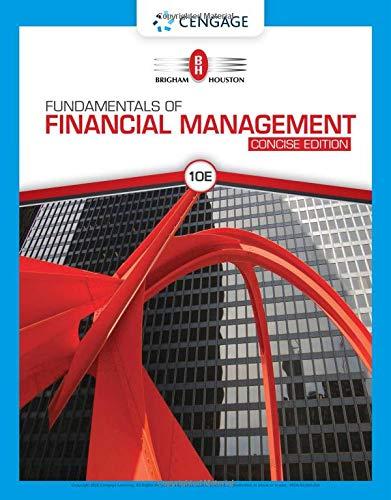Review Questions All Review Questions are available in MyLab Finance. 15-1. Dell Computer Corporation (DELL) has long been recognized for its innova- tive approach to managing its working capital. Describe how Dell pioneered the management of net working capital to free up resources in the firm. 15-2. Define and contrast the terms working capital and net working capital. 15-3. Discuss the risk-return relationship involved in the firm's asset-investment decisions as that relationship pertains to its working capital management. 15-4. What advantages and disadvantages are generally associated with the use of short-term debt? Discuss. 15-5. Explain what is meant by the statement "The use of current liabilities as opposed to long-term debt subjects the firm to a greater risk of illiquidity." 15-6. Define the hedging principle. How can this principle be used in the manage- ment of working capital? 15-7. Define the following terms: a. Permanent asset investments b. Temporary asset investments c. Permanent sources of financing d. Temporary sources of financing e. Spontaneous sources of financing 15-8. How can the formula "interest = principle X rate X time" be used to esti- mate the cost of short-term credit? 15-9. How can we accommodate the effects of compounding in our calculation of the effective cost of short-term credit? 15-10. There are three major sources of unsecured short-term credit other than accrued wages and taxes. List and discuss the distinguishing characteristics of each. 15-11. What is meant by the following trade credit terms: 2/10, net 30? 4/20, net 60? 3/15, net 45? 15-12. Define the following: a. Line of credit b. Commercial paper c. Compensating balance d. Prime rate
Review Questions All Review Questions are available in MyLab Finance. 15-1. Dell Computer Corporation (DELL) has long been recognized for its innova- tive approach to managing its working capital. Describe how Dell pioneered the management of net working capital to free up resources in the firm. 15-2. Define and contrast the terms working capital and net working capital. 15-3. Discuss the risk-return relationship involved in the firm's asset-investment decisions as that relationship pertains to its working capital management. 15-4. What advantages and disadvantages are generally associated with the use of short-term debt? Discuss. 15-5. Explain what is meant by the statement "The use of current liabilities as opposed to long-term debt subjects the firm to a greater risk of illiquidity." 15-6. Define the hedging principle. How can this principle be used in the manage- ment of working capital? 15-7. Define the following terms: a. Permanent asset investments b. Temporary asset investments c. Permanent sources of financing d. Temporary sources of financing e. Spontaneous sources of financing 15-8. How can the formula "interest = principle X rate X time" be used to esti- mate the cost of short-term credit? 15-9. How can we accommodate the effects of compounding in our calculation of the effective cost of short-term credit? 15-10. There are three major sources of unsecured short-term credit other than accrued wages and taxes. List and discuss the distinguishing characteristics of each. 15-11. What is meant by the following trade credit terms: 2/10, net 30? 4/20, net 60? 3/15, net 45? 15-12. Define the following: a. Line of credit b. Commercial paper c. Compensating balance d. Prime rate
Chapter7: Types And Costs Of Financial Capital
Section: Chapter Questions
Problem 24DQ
Related questions
Question
Please help with questions

Transcribed Image Text:Review Questions
All Review Questions are available in MyLab Finance.
15-1. Dell Computer Corporation (DELL) has long been recognized for its innova-
tive approach to managing its working capital. Describe how Dell pioneered the
management of net working capital to free up resources in the firm.
15-2. Define and contrast the terms working capital and net working capital.
15-3. Discuss the risk-return relationship involved in the firm's asset-investment
decisions as that relationship pertains to its working capital management.
15-4. What advantages and disadvantages are generally associated with the use of
short-term debt? Discuss.
15-5. Explain what is meant by the statement "The use of current liabilities as
opposed to long-term debt subjects the firm to a greater risk of illiquidity."
15-6. Define the hedging principle. How can this principle be used in the manage-
ment of working capital?
15-7. Define the following terms:
a. Permanent asset investments
b. Temporary asset investments
c. Permanent sources of financing
d. Temporary sources of financing
e. Spontaneous sources of financing
15-8. How can the formula "interest = principle X rate X time" be used to esti-
mate the cost of short-term credit?
15-9. How can we accommodate the effects of compounding in our calculation of
the effective cost of short-term credit?
15-10. There are three major sources of unsecured short-term credit other than
accrued wages and taxes. List and discuss the distinguishing characteristics of each.
15-11. What is meant by the following trade credit terms: 2/10, net 30? 4/20, net 60?
3/15, net 45?
15-12. Define the following:
a. Line of credit
b. Commercial paper
c. Compensating balance
d. Prime rate
Expert Solution
This question has been solved!
Explore an expertly crafted, step-by-step solution for a thorough understanding of key concepts.
Step by step
Solved in 2 steps with 1 images

Recommended textbooks for you


Fundamentals Of Financial Management, Concise Edi…
Finance
ISBN:
9781337902571
Author:
Eugene F. Brigham, Joel F. Houston
Publisher:
Cengage Learning

Cornerstones of Financial Accounting
Accounting
ISBN:
9781337690881
Author:
Jay Rich, Jeff Jones
Publisher:
Cengage Learning


Fundamentals Of Financial Management, Concise Edi…
Finance
ISBN:
9781337902571
Author:
Eugene F. Brigham, Joel F. Houston
Publisher:
Cengage Learning

Cornerstones of Financial Accounting
Accounting
ISBN:
9781337690881
Author:
Jay Rich, Jeff Jones
Publisher:
Cengage Learning

Intermediate Accounting: Reporting And Analysis
Accounting
ISBN:
9781337788281
Author:
James M. Wahlen, Jefferson P. Jones, Donald Pagach
Publisher:
Cengage Learning

Managerial Accounting: The Cornerstone of Busines…
Accounting
ISBN:
9781337115773
Author:
Maryanne M. Mowen, Don R. Hansen, Dan L. Heitger
Publisher:
Cengage Learning

Fundamentals of Financial Management (MindTap Cou…
Finance
ISBN:
9781337395250
Author:
Eugene F. Brigham, Joel F. Houston
Publisher:
Cengage Learning